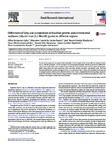Please use this identifier to cite or link to this item:
http://www.alice.cnptia.embrapa.br/alice/handle/doc/1007339| Title: | Differences of fatty acid composition in brazilian genetic and conventional soybeans (Glycine max (L.) Merrill) grown in different regions. |
| Authors: | GALÃO, O. F.  CARRÃO-PANIZZI, M. C.   MANDARINO, J. M. G.   SANTOS JÚNIOR, O. O.   MARUYAMA, S. A.   FIGUEIREDO, L. C.   BONAFE, E. G.   VISENTAINER, J. V.   |
| Affiliation: | OLÍVIO FERNANDES GALÃO, UEL; MERCEDES CONCÓRDIA CARRÃO-PANIZZI, CNPT; JOSÉ MARCOS GONTIJO MANDARINO, CNPSO; OSCAR OLIVEIRA SANTOS JÚNIOR, UEM; SWAMI ARÊA MARUYAMA, UEM; LUANA CAROLINE FIGUEIREDO, UTFPR; ELTON GUNTENDORFER BONAFE, UTFPR; JESUI VERGILIO VISENTAINER, UEM. |
| Date Issued: | 2014 |
| Citation: | Food Research International, Barking, v. 62, p. 589-594, Aug. 2014. |
| Description: | The aim of this study was to compare fatty acid profiles of seed samples from twenty different soybean (Glycine max (L.) Merrill) genotypes (14 non-transgenic and six transgenic Roundup-tolerant) grown at two different locations, both in the Parana state, a southern region of Brazil. A total of eleven fatty acids were detected and quantified, among them the most expressive ones were oleic, linoleic, linolenic and palmitic acids. The total unsaturated fatty acid amount was higher than 82%. An increase in the n-3 fatty acids quantities were observed in transgenic species, which can be reflected in lower n-6/n-3 ratios, a highly desired trend regarding consumers' health. In conclusion, results showed a large amount of variation among the different germplasms (either conventional or transgenic) within and across locations. |
| Thesagro: | Ácido Graxo Soja |
| Keywords: | Soybean |
| ISSN: | 0963-9969 |
| DOI: | 10.1016/j.foodres.2014.04.025 |
| Type of Material: | Artigo de periódico |
| Access: | openAccess |
| Appears in Collections: | Artigo em periódico indexado (CNPT)  |
Files in This Item:
| File | Description | Size | Format | |
|---|---|---|---|---|
| 2014FoodResearchInternationalv62p589.pdf | 491.6 kB | Adobe PDF |  View/Open |









